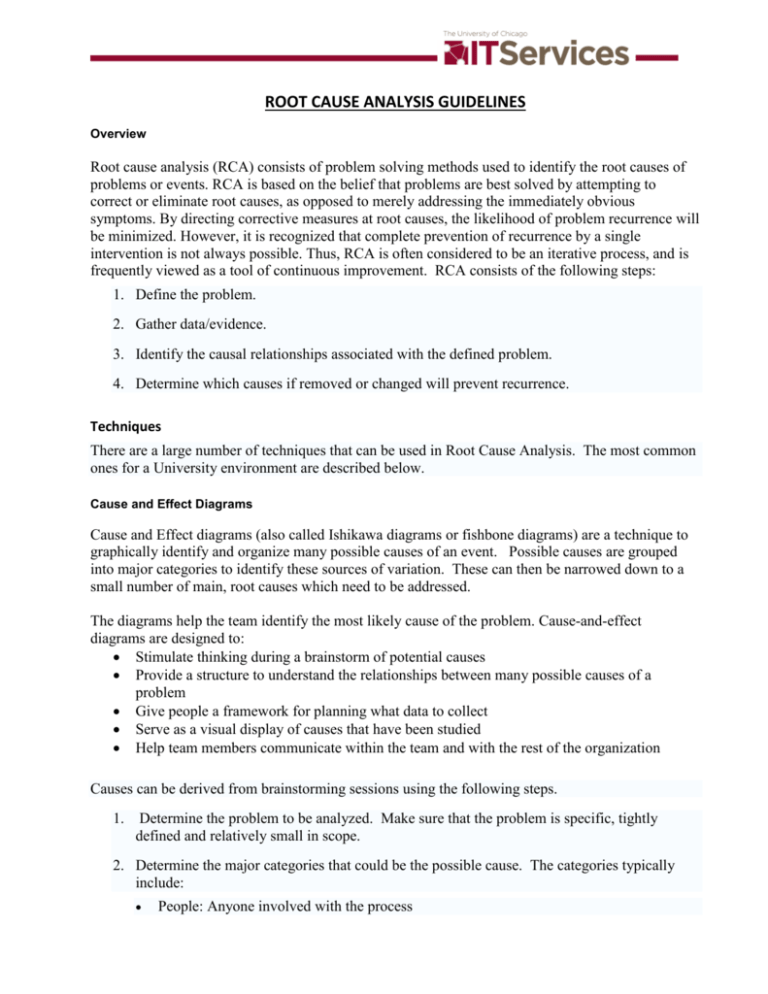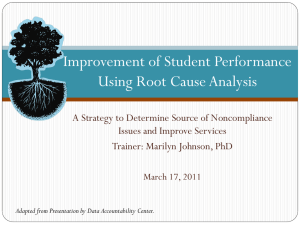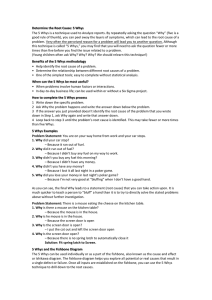Root Cause Analysis Guidelines
advertisement

ROOT CAUSE ANALYSIS GUIDELINES Overview Root cause analysis (RCA) consists of problem solving methods used to identify the root causes of problems or events. RCA is based on the belief that problems are best solved by attempting to correct or eliminate root causes, as opposed to merely addressing the immediately obvious symptoms. By directing corrective measures at root causes, the likelihood of problem recurrence will be minimized. However, it is recognized that complete prevention of recurrence by a single intervention is not always possible. Thus, RCA is often considered to be an iterative process, and is frequently viewed as a tool of continuous improvement. RCA consists of the following steps: 1. Define the problem. 2. Gather data/evidence. 3. Identify the causal relationships associated with the defined problem. 4. Determine which causes if removed or changed will prevent recurrence. Techniques There are a large number of techniques that can be used in Root Cause Analysis. The most common ones for a University environment are described below. Cause and Effect Diagrams Cause and Effect diagrams (also called Ishikawa diagrams or fishbone diagrams) are a technique to graphically identify and organize many possible causes of an event. Possible causes are grouped into major categories to identify these sources of variation. These can then be narrowed down to a small number of main, root causes which need to be addressed. The diagrams help the team identify the most likely cause of the problem. Cause-and-effect diagrams are designed to: Stimulate thinking during a brainstorm of potential causes Provide a structure to understand the relationships between many possible causes of a problem Give people a framework for planning what data to collect Serve as a visual display of causes that have been studied Help team members communicate within the team and with the rest of the organization Causes can be derived from brainstorming sessions using the following steps. 1. Determine the problem to be analyzed. Make sure that the problem is specific, tightly defined and relatively small in scope. 2. Determine the major categories that could be the possible cause. The categories typically include: People: Anyone involved with the process Methods: How the process is performed and the specific requirements for doing it, such as policies, procedures, rules, regulations and laws Machines: Any equipment, computers, tools etc. required to accomplish the job Materials: Raw materials, parts, pens, paper, etc. used to produce the final product Measurements: Data generated from the process that are used to evaluate its quality Environment: The conditions, such as location, time, temperature, and culture in which the process operates Note: these categories may not fit every situation and different categories might be appropriate. However, the total number of categories should not exceed six. 3. Set up a blank diagram on a white board or flip chart. Enter the problem in the Effect box and the categories identified in Step 2 along the spines. 4. Brainstorm all possible causes and label each cause under the appropriate category. (For more detail, see Section 2.4 Brainstorming). It is useful to write the possible causes on Post It Notes first, assign them to categories after the brainstorming is finished and then place the Post Its on the diagram. Page 2 of 4 5. Rank all possible causes according to likeliness to be a root cause and circle the most likely ones for further study and consideration. 6. Investigate the circled causes. Brainstorming Brainstorming is a process in which a group quickly generates as many ideas as it can on a particular problem. Brainstorming is useful because it uses the collective brainpower of the group to generate many ideas. Guidelines for conducting a successful brainstorming session are: Collect a mixed team representing all parts of the process Have impartial facilitator conduct the session. The facilitator should not lead the session, but keep it moving and prevent value judgements from being made Assign two people to write ideas down on a flip chart or white board so that all ideas are captured Go for quantity rather than quality of ideas; ideas can be ranked later No judgements – every idea is a good idea Stop the session after sufficient ideas have been gathered Five Whys The Five Whys is a question-asking method used to explore the cause/effect relationships underlying a particular problem. Ultimately, the goal of applying the Five Whys method is to determine a root cause of a defect or problem. The following example demonstrates the basic process: 1. Write down the specific problem, i.e. My car will not start. This helps formalize the problem and describe it completely. 2. Ask Why the problem happens and write down the answer below the problems, i.e.the battery is dead. 3. Ask Why again and write that answer down, i.e. the alternator is not functioning. 4. Repeat asking Why until you feel the root cause has been reached. This may be more or less than five whys. The "five" in Five Whys is not gospel; rather, it is postulated that five iterations of asking why is generally sufficient to get to a root cause. The real key is to encourage the troubleshooter to avoid assumptions and logic traps and instead to trace the chain of causality in direct increments from the effect through any layers of abstraction to a root cause that still has some connection to the original problem. Page 3 of 4 Although a generally accepted technique, the Five Whys has its drawbacks: Tendency for investigators to stop at symptoms rather than going on to lower level root causes. Inability to go beyond the investigator's current knowledge - can't find causes that they don't already know Lack of support to help the investigator to ask the right "why" questions. Answers to the Whys are different depending on who is being asked. Workflow Diagrams Flow diagrams (Flow Charts) provide a visual representation of how a process is structured by showing individual events within the process, and the interactions between these processes. They provide a valuable tool for understanding and analyzing how processes work Page 4 of 4








